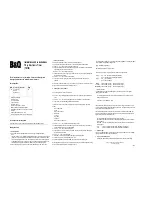
4.3
Electrical connections
Carry out the electrical wiring by connecting only one wire to
each terminal, according to the following diagram, checking
that power supply is the same as indicated on the instrument
and the load current absorption is no higher than the maxi-
mum electricity current permitted.
As the instrument is built-in equipment with permanent con-
nection inside housing, it is not equipped with either switches
or internal devices to protect against current overloads: the
installation will include an overload protection and a two-
phase circuit-breaker, placed as near as possible to the in-
strument and located in a position that can easily be reached
by the user and marked as
instrument disconnecting
device
which interrupts the power supply to the equipment.
It is also recommended that the supply of all the electrical circuits
connected to the instrument must be properly protected, using
devices (ex. fuses) proportionate to the circulating currents.
It is strongly recommended that cables with proper insulation,
according to the working voltages and temperatures, be used.
If some cables are shielded, the shield must be connected to
ground at only one side.
D
D
Moreover, check that the parameters set are the de-
sired ones and the application works correctly
before
connecting the outputs to the actuators
in order to
avoid malfunctions in the plant that could cause dam-
age to people, things or animals.
4.3.1
Electrical connection diagram
Out1 16 (9)A 10 (4)A 12A Res.
30 LRA
5 FLA
Out2 5 (1)A 2 (1)A 2A Gen. Use
(12 A max. for ext. conn. models)
SSR: 12 VDC, 15 mA
61810
EN
60730
EN
UL
External
Buzzer
SUPPLY
OUT1
OUT2
NC
NO
C
NO
C
1 2 3 4 5 6 7 8 9 101112
INPUTS
+
-
+
-
T
X40
RST CNT
Internal
Buzzer
5. OPERATING MODE
5.1
Display operation
CNT
LED indicates:
–
Count in progress (flashing);
–
Count stopped before the end (steady on);
–
Count ended/Reset status (off).
After Reset display shows
0000
when counting mode is
UP
(
F.Cnt
=
uP
) or
Set time
value if the count mode is
DOWN
(
F.Cnt
=
dn
).
While counting display shows the time that elapses: increas-
ing if
F.Cnt
=
uP
or decreasing if
F.Cnt
=
dn
.
For functions that require a cycle end (
F.o1t
=
1
,
2
) at the
end of the count, the display flashes:
0000
if
F.Cnt
=
dn
or
the
Set time
value if
F.Cnt
=
uP
.
5.2
Operation of the Counting commands
Counting can be enabled and disabled using the
-Start/
Stop
key or via the digital inputs
CNT
and
RST
.
The operating mode of the
-Start/Stop
key is established
by parameters
t.UFt
and
I.Fct
, the operating mode of
CNT
input is established by
i.Fct
parameter while the
RST
input
always acts as a
Reset
, i.e.
blocks
and
resets
the count
when it is activated and also has priority over the other com-
mands (while
RST
is active, the count cannot start).
The counting
Start
signal can therefore be given by the
-Start/Stop
key, which normally has bistable (toggle)
operation, or via the
CNT
count enable digital input.
The operating mode of the
CNT
input can be programmed
using the
i.Fct
parameter to operate in different modes:
i.Fct
=
1
-
Bistable Start/Stop
By activating the
CNT
input the count starts and it is
therefore possible to deactivate the input.
Activating
CNT
again, the count stops on the value reached
(without disabling the output if this was activated), the next
CNT
impulse resumes the count from the point it stopped
and so on until the end of the count or the
Reset
signal.
In this mode, the front
-Start/Stop
button (if
t.UFt
=
2
)
acts exactly in the same way as the
CNT
input with the
addition that, when kept pressed for 2 s during the count-
ing, carries out the
Reset
command.
If the counting is finished, pressing the key carries out
the
Reset-Start
command at the same time.
CNT
Count
RESET
0 . 1 . 2 . 3 . 4 . 5
. 6 . 7 . 8 . 0
i.fct
=
1
Start
Stop
Start
Stop/
Reset
ELETTROMECCANICA CDC S.r.l - TX40
- MANUAL rev.2 - PAG.
5
Nota: attenzione schema collegamento,
new pin input e output.





























